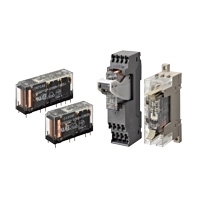| Item | Rated current (mA) | Coil resistance (Ω) | Max. voltage (V) | Power consumption (mW) |
|---|---|---|---|---|
| Rated voltage | ||||
| 12 VDC | 30 | 400 | 110% | Approx. 360 |
| 18 VDC | 20 | 900 | ||
| 21 VDC | 17.1 | 1,225 | ||
| 24 VDC | 15 | 1,600 | ||
| 48 VDC | 7.5 | 6,400 | ||
| 110 VDC | 3.8 | 28,810 | Approx. 420 |
Relays with Forcibly Guided Contacts

about this Product Family
last update: October 03, 2016
| Item | Rated current (mA) | Coil resistance (Ω) | Max. voltage (V) | Power consumption (mW) |
|---|---|---|---|---|
| Rated voltage | ||||
| 12 VDC | 30 | 400 | 110% | Approx. 360 |
| 18 VDC | 20 | 900 | ||
| 21 VDC | 17.1 | 1,225 | ||
| 24 VDC | 15 | 1,600 | ||
| 48 VDC | 7.5 | 6,400 | ||
| 110 VDC | 3.8 | 28,810 | Approx. 420 |
| Item | Rated current (mA) | Coil resistance (Ω) | Max. voltage (V) | Power consumption (mW) |
|---|---|---|---|---|
| Rated voltage | ||||
| 12 VDC | 41.7 | 288 | 110% | Approx. 500 |
| 18 VDC | 27.8 | 648 | ||
| 21 VDC | 23.8 | 882 | ||
| 24 VDC | 20.8 | 1,152 | ||
| 48 VDC | 10.4 | 4,606 | ||
| 110 VDC | 5.3 | 20,862 | Approx. 580 |
Note: 1. The rated current and coil resistance are measured at a coil temperature of 23°C with tolerances of ±15%.
2. The maximum voltage is based on an ambient operating temperature of 23°C maximum.
| Load | Resistive load |
|---|---|
| Rated load | 6 A at 250 VAC, 6 A at 30 VDC |
| Rated carry current | 6 A |
| Max. switching voltage | 250 VAC, 125 VDC |
| Max. switching current | 6 A |
| Contact materials | Au plating + Ag alloy |
| Contact resistance *1 | 100 mΩ max. | |
|---|---|---|
| Operating time *2 | 20 ms max. | |
| Response time *3 | 10 ms max. | |
| Release time *2 | 20 ms max. | |
| Must operate voltage | 75% max. | |
| Must release voltage | 10% min. | |
| Maximum
operating frequency |
Mechanical | 36,000 operations/h |
| Rated load | 1,800 operations/h | |
| Insulation resistance *4 | 1,000 MΩ min. | |
| Dielectric
Strength *5 *6 |
Between coil
and contacts |
4,000 VAC, 50/60 Hz for 1 min. |
| Between contacts
of different polarity |
4,000 VAC, 50/60 Hz for 1 min. (except for followings)
4 poles (for poles 3-4 in 4-pole Relays), 6 poles (for poles 3-5, 4-6, and 5-6 in 6-pole Relays): 2,500 VAC, 50/60 Hz for 1 min. |
|
| Between contacts
of the same polarity |
1,500 VAC, 50/60 Hz for 1 min. | |
| Vibration resistance | 10 to 55 to 10 Hz, 0.75-mm single amplitude (1.5-mm double amplitude) | |
| Shock
resistance |
Destruction | 1,000 m/s2 |
| Malfunction | 100 m/s2 | |
| Durability
*7 |
Mechanical | 10,000,000 operations min. (at approx. 36,000 operations/h) |
| Electrical | 100,000 operations min. (at the rated load and approx. 1,800 operations/h) | |
| Inductive load switching
capability *8 (IEC60947-5-1) |
AC15 AC240V 2A
DC13 DC24V 1A |
|
| Failure rate (P level)
(reference value *9) |
5 VDC, 1 mA | |
| Ambient operating
temperature *10 |
12 to 48 VDC: -40 to 85°C (with no icing or condensation)
110 VDC: -40 to 60°C (with no icing or condensation) |
|
| Ambient operating
humidity |
5% to 85% RH | |
| Weight | 4 poles: Approx. 22 g
6 poles: Approx. 25 g |
|
| Model | Push-In Plus terminals | Screw terminals | PCB terminals | ||||
|---|---|---|---|---|---|---|---|
| 4 poles | 6 poles | 4 poles | 6 poles | 4 poles | 6 poles | ||
| P7SA-10F-ND-PU | P7SA-14F-ND-PU | P7SA-10F(-ND) | P7SA-14F(-ND) | P7SA-10P | P7SA-14P | ||
| Ambient operating temperature | • With operation indicator LED/built-in diode
P7SA-[]F-ND(-PU): -20 to +70°C • Without operation indicator LED/built-in diode P7SA-[]F: -40 to +85°C (with no icing or condensation) |
-40 to +85°C
(with no icing or condensation) |
|||||
| Ambient operating humidity | 25 to 85% RH | 5 to 85% RH | |||||
| Continuous carry current | 6 A *1 | ||||||
| Dielectric
strength |
Between coil
and contact terminals |
4,000 VAC for 1 min. | 2,500 VAC for 1 min. | ||||
| Between contact
terminals of different polarity |
2,500 VAC for 1 min. | ||||||
| Between contact
terminals of same polarity |
1,500 VAC for 1 min. | ||||||
| Insulation resistance | 1,000 MΩ min. *2 | ||||||
| Weight | Approx. 58 g | Approx. 70 g | Approx. 44 g | Approx. 59 g | Approx. 9 g | Approx. 10 g | |
*1. When operating the P7SA-[]F-ND-PU at a temperature between 50 and 70°C, reduce the continuous current
(6 A at 50°C or less) by 0.25 A for each degree above 50°C.
When operating the P7SA-[]F-ND at a temperature between 50 and 70°C, reduce the continuous current
(6 A at 50°C or less) by 0.3 A for each degree above 50°C.
When operating the P7SA-[]F at a temperature between 50 and 85°C, reduce the continuous current
(6 A at 50°C or less) by 0.1 A for each degree above 50°C.
*2. Measurement conditions: For 500 VDC applied to the same location as for dielectric strength measurement.
last update: October 03, 2016